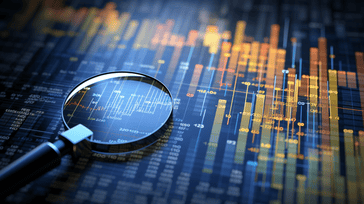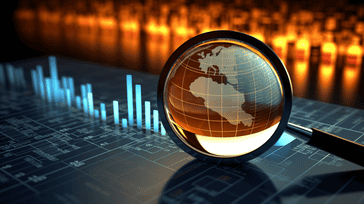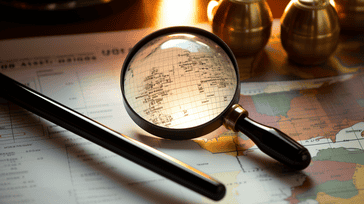Economic Indicators and the Business Environment: Assessing Opportunities

As a business owner or decision-maker, it's essential to stay informed about the economic climate and understand how it impacts your company's growth potential. Economic indicators serve as valuable tools for assessing the business environment and identifying opportunities for growth. By analyzing economic indicators, you can gain insights into market trends and make informed decisions that align with the overall health of the economy.
Key Takeaways
- Economic indicators are essential tools for assessing the business environment.
- Understanding economic indicators can help businesses make informed decisions.
- Analyzing economic indicators can provide insights into market trends.
- Researching economic indicators is crucial for staying informed about the current economic climate.
- Applying economic indicators to decision-making can help identify potential opportunities for growth.
Understanding Economic Indicators
Economic indicators are crucial tools for assessing the health of an economy. By definition, economic indicators are statistical metrics used to measure and track economic trends, including production, employment rates, and inflation. These metrics can provide valuable insights into the overall economic climate and help guide business decisions.
Economic Indicators Definition
There are several different types of economic indicators, including leading, lagging, and coincident indicators. Leading indicators are used to forecast changes in the economy, while lagging indicators reflect changes that have already occurred. Coincident indicators move in tandem with the economy and are used to confirm current economic trends.
Some of the most commonly used economic indicators include the Gross Domestic Product (GDP), the Consumer Price Index (CPI), and the Purchasing Managers' Index (PMI). The GDP measures the total value of goods and services produced within a country's borders, while the CPI tracks changes in the cost of a basket of goods and services over time. The PMI measures the level of activity in the manufacturing sector and can provide valuable insights into broader economic trends.
Understanding the different types of economic indicators and how they are used can help businesses make informed decisions and stay ahead of the curve.
Leading Economic Indicators

In the previous section, we defined what economic indicators are and their significance in measuring the overall health of an economy. Leading economic indicators, as the name suggests, are among the most important indicators that businesses should pay attention to. These indicators provide insight into the future direction of the economy and can help business leaders anticipate potential changes before they occur.
Examples of leading economic indicators include:
| Economic Indicator | Description |
|---|---|
| Stock Market Trends | The trends in the stock market can indicate how investors perceive the future of the economy. |
| Building Permits | Building permits are a sign of the construction industry's future activity and demand for housing. |
| Consumer Expectations | Consumer expectations can provide insight into future spending patterns and economic growth potential. |
It is important to note that no single leading economic indicator can accurately predict changes in the economy. However, by analyzing a combination of indicators, businesses can gain a more complete understanding of the economic climate and make better-informed decisions.
Lagging Economic Indicators: Examples and Significance
Lagging economic indicators measure changes that have already occurred in the economy, providing a better understanding of the overall health of the economy. Unlike leading indicators, lagging indicators reflect past trends and help confirm whether a particular economic trend has occurred.
Businesses can use lagging indicators to assess the impact of economic changes on their operations and make informed decisions. Here are some examples of lagging economic indicators:
| Indicator | Description |
|---|---|
| Gross Domestic Product (GDP) | GDP measures the total value of goods and services produced in an economy. It is a lagging indicator because it takes time to calculate and only reflects economic activity that has already happened. |
| Unemployment rate | The unemployment rate measures the percentage of the labor force that is unemployed. It is a lagging indicator because it reflects the impact of economic changes on employment after they occur. |
| Consumer Price Index (CPI) | The CPI measures the changes in prices of a basket of goods and services over time. It is a lagging indicator because it reflects price changes that have already occurred. |
Lagging indicators are significant because they provide a more comprehensive view of the economy and can help businesses prepare for changes that have already happened. They can confirm the effectiveness of business strategies and help identify areas for improvement.
Analyzing Economic Indicators

Once economic indicators have been identified and tracked, it is essential to analyze the data to understand what it means for your business. Economic indicators analysis involves interpreting the data and using it to make informed decisions that align with market trends and potential opportunities.
One way to analyze economic indicators is through forecasting. Economic indicators forecasting involves using historical data and statistical models to predict future trends. This can give businesses an idea of what to expect in the coming months or years, allowing them to plan and make strategic decisions accordingly.
Methods for Economic Indicators Analysis
There are several methods businesses can use to analyze economic indicators. One common method is trend analysis, which involves identifying patterns in the data over time. For example, if there is a consistent increase in a particular economic indicator over several months or years, it may indicate a growing trend that could affect businesses in that industry.
Another analysis method is comparative analysis, which involves comparing economic indicators to each other or to industry averages. This can help identify areas where a business may be underperforming or where there may be potential for growth.
Regression analysis is another method that can be used to analyze economic indicators. This involves looking at the relationship between two or more variables to determine how they affect each other. For example, a business may use regression analysis to determine how changes in interest rates affect consumer spending in their industry.
The Role of Economic Indicators Forecasting
Economic indicators forecasting can provide businesses with valuable insights into future market trends. By predicting changes in the economy, businesses can plan ahead, adjust their strategies, and take advantage of potential opportunities. However, it is important to remember that economic indicators forecasting is not always accurate and should be used in conjunction with other analysis methods to make informed decisions.
It is also important to keep in mind that economic indicators analysis is not a one-time process. The economy is constantly changing, and businesses need to continuously monitor and analyze economic indicators to stay up-to-date with market trends and potential opportunities.
In the next section, we will highlight the importance of economic indicators in understanding the business environment and identifying potential opportunities.
The Importance of Economic Indicators
Economic indicators are a crucial tool for businesses seeking to stay abreast of market trends and identify potential opportunities for growth. By providing a snapshot of the overall health of the economy, economic indicators can help businesses make informed decisions that align with prevailing market conditions.
The importance of economic indicators lies in their ability to provide real-time data on key economic metrics, such as employment rates, inflation, and economic growth. This data can be used to inform strategic planning and guide decision-making, helping businesses identify potential risks and opportunities in the market.
Tracking Economic Trends
One of the primary benefits of economic indicators is their ability to track current economic trends and predict future ones. By monitoring leading economic indicators, such as consumer confidence, businesses can anticipate changes in the market and adjust their operations accordingly.
Likewise, lagging economic indicators, such as GDP figures, can help businesses understand the impact of changes that have already occurred in the economy. By analyzing these figures, businesses can gain valuable insights into the current state of the market and make informed decisions about their future operations.
Informing Decision-Making
Economic indicators can be a valuable tool for businesses seeking to make informed decisions about everything from staffing levels to marketing strategies. By analyzing economic data, businesses can identify potential opportunities for growth and optimize their operations to take advantage of prevailing market conditions.
For example, if economic indicators suggest that consumer spending is on the rise, businesses may choose to increase their marketing budgets to capitalize on this trend. Alternatively, if economic growth is expected to slow, businesses may choose to scale back operations or adjust their product offerings to better align with market conditions.
Staying Ahead of the Competition
In today's fast-paced business environment, staying ahead of the competition is more important than ever. By closely monitoring economic indicators, businesses can stay abreast of market trends and identify potential opportunities before their competitors do.
For example, if an economic indicator suggests that a particular market is poised for growth, businesses can position themselves to take advantage of this trend before their competitors do. Similarly, by analyzing economic data, businesses can identify potential risks and adjust their strategies to mitigate them.
Conclusion
The importance of economic indicators cannot be overstated. By providing real-time data on key economic metrics, economic indicators can help businesses make informed decisions and stay ahead of the competition. By analyzing economic data and tracking prevailing market trends, businesses can position themselves for success and optimize their operations for long-term growth.
Researching Economic Indicators

Researching economic indicators is vital for businesses to gain insightful perspectives into the current economic climate. With the help of accurate and reliable data, businesses can make informed decisions and navigate market trends efficiently.
One of the most reliable sources of economic data is the Bureau of Economic Analysis, which provides detailed reports and analysis of various economic indicators. These reports can be accessed through their website, which also offers interactive tools and applications to aid in data interpretation.
Effective Research Methods
Businesses can employ a variety of research methods to analyze economic indicators, ranging from primary research to secondary research. Primary research involves collecting data directly from customers or stakeholders, while secondary research makes use of pre-collected data from external sources.
Focus groups, surveys, and interviews are effective primary research methods that businesses can employ to collect data on consumer sentiment, preferences, and spending behavior.
On the other hand, secondary research methods include using published reports, industry statistics, and government data sources. These sources can provide businesses with detailed insights into the economic climate and market trends.
Interpreting Economic Data
Interpreting economic data requires a sound understanding of economics and statistical analysis. Businesses can use various techniques and tools to forecast trends and identify potential opportunities for growth.
| Technique/Tool | Description |
|---|---|
| Regression analysis | Helps identify relationships between different economic indicators and how they affect market trends. |
| Trend analysis | Identifies patterns and trends in economic data over an extended time period. |
| Scenario analysis | Provides an overview of how different scenarios and events could impact the economy and business operations. |
By utilizing these techniques and tools, businesses can analyze economic data more accurately and make well-informed decisions that align with market trends.
Applying Economic Indicators in Decision-Making
Assessing economic indicators is critical for businesses aiming to make informed decisions in today's highly competitive marketplace. By analyzing different economic indicators, businesses can assess the current business environment and identify potential opportunities for growth and development.
One way to apply economic indicators is by using them to inform strategic planning. Businesses can use economic data to guide their decision-making processes and make informed choices based on current market trends. For instance, businesses can assess the state of the economy by examining data on GDP, unemployment rates, and inflation. These indicators can help businesses forecast future trends and make decisions that align with current market conditions.
Another way to apply economic indicators is to identify potential growth opportunities. Businesses can analyze economic data to identify sectors with high growth potential or areas that are likely to experience an upswing in demand. For example, a business could use data on consumer spending habits to identify markets that are likely to experience growth in the near future.
Finally, economic indicators can help businesses manage risk. By analyzing economic data, businesses can anticipate potential risks and make proactive decisions to mitigate them. For example, a business could use data on interest rates to anticipate changes in borrowing costs and make decisions accordingly.
Case Study: How Economic Indicators Helped ABC Corporation
"By analyzing key economic indicators, ABC Corporation was able to identify an emerging market with high potential for growth. The company used this data to focus its strategic planning efforts and develop a successful product line tailored to the needs of this market. As a result, ABC Corporation was able to increase its revenue and establish a strong foothold in a rapidly growing industry."
This example illustrates how businesses can use economic indicators to inform decision-making and capitalize on potential opportunities. By analyzing different economic indicators, businesses can gain valuable insights into the current business environment and make strategic choices that align with market trends.
Overall, applying economic indicators is crucial for businesses aiming to make informed decisions and stay competitive in today's marketplace. By leveraging economic data, businesses can assess the business environment, identify potential opportunities, and manage risk, all of which are crucial for success in today's fast-paced and dynamic business environment.
Conclusion
Economic indicators are vital metrics that offer a clear picture of the state of an economy. As explored in this article, understanding the different types of economic indicators and analyzing them can help businesses make informed decisions and assess potential opportunities.
By keeping a close watch on economic indicators and conducting research, businesses can gain insights into the current business environment and stay ahead of market trends. Furthermore, applying economic indicators to decision-making processes is crucial for businesses to make informed and optimized choices.
In summary, economic indicators are essential tools for businesses that seek growth and success. Stay tuned for further insights on how businesses can leverage these indicators to their advantage.
FAQ
What are economic indicators?
Economic indicators are statistical measures used to evaluate and analyze the overall health and performance of an economy. They provide insights into factors such as employment, inflation, GDP growth, consumer spending, and business investment.
How are economic indicators used to assess opportunities in the business environment?
Economic indicators serve as valuable tools for businesses to assess opportunities and make informed decisions. By monitoring these indicators, businesses can identify trends, anticipate changes in the market, and adjust their strategies accordingly. For example, a rise in consumer spending may indicate increased demand for certain products or services, presenting an opportunity for businesses to expand or introduce new offerings.
What are leading economic indicators?
Leading economic indicators are variables or measures that tend to change before the overall economy starts to follow a particular trend. They are used to predict future economic conditions. Examples of leading indicators include stock market performance, building permits, and consumer confidence indexes.
What are lagging economic indicators?
Lagging economic indicators are variables or measures that change after the overall economy has already started following a particular trend. They confirm or reflect changes that have already occurred. Examples of lagging indicators include unemployment rate, consumer price index (CPI), and average duration of unemployment.
How can businesses analyze economic indicators?
Businesses can analyze economic indicators by closely monitoring the relevant data and trends. This analysis typically involves assessing the relationships and correlations between different indicators, identifying patterns and predictive factors, and using statistical techniques to interpret the information. Additionally, businesses can utilize forecasting models and economic analysis tools to gain deeper insights and make more accurate predictions.
Why are economic indicators important for businesses?
Economic indicators are important for businesses as they provide crucial information about the overall economic conditions, market trends, and potential opportunities or risks. By staying informed about these indicators, businesses can make informed decisions regarding pricing, production, hiring, investments, and overall strategic planning, helping them stay competitive and maximize their chances of success.
How can businesses research economic indicators?
Businesses can research economic indicators by accessing reliable sources such as government publications, central bank reports, economic research institutions, and reputable financial news outlets. Additionally, utilizing specialized market research firms or subscribing to economic data services can provide businesses with comprehensive and up-to-date information on relevant economic indicators.
How can businesses apply economic indicators in decision-making?
Businesses can apply economic indicators in their decision-making processes by using the insights gained from analyzing these indicators to inform strategies, establish realistic goals, and identify potential opportunities or threats. For example, if GDP growth is projected to slow down, businesses may take measures to improve efficiency, diversify their product offerings, or explore new markets to mitigate potential adverse effects.
